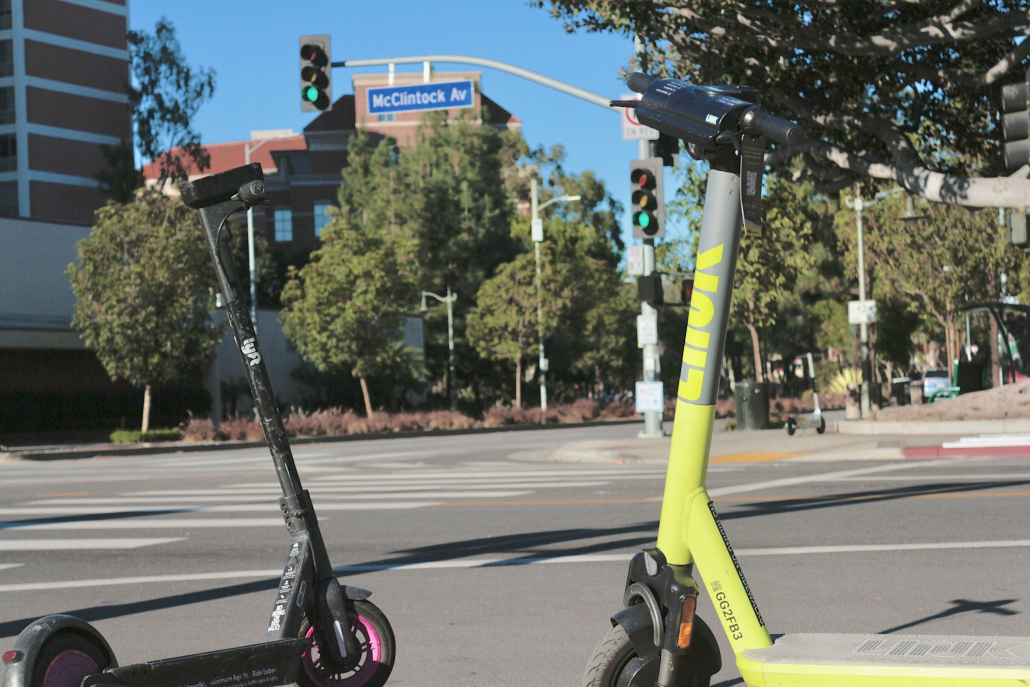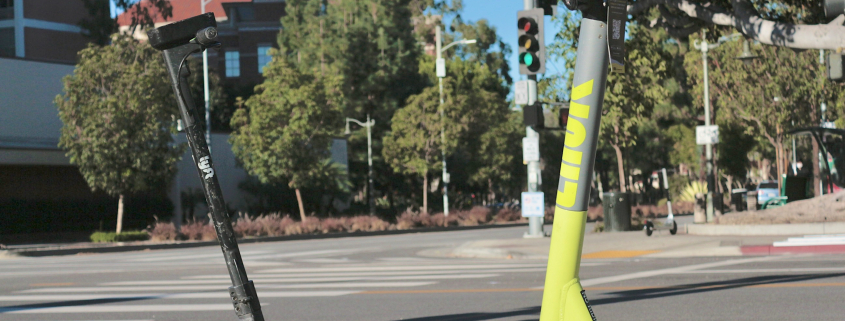E-scooter collisions rise near campus

A habitual ride on an electric scooter ended in an ER visit and a semester off for Ty Kawamura. As he rode out of an alley on 28th St., Kawamura, who said he always follows the rules of the road while on an e-scooter, was hit and run over by an SUV. After spending the fall semester at home and healing from his injuries, Kawamura, a sophomore majoring in economics, said he won’t be riding e-scooters again.
According to interim Department of Public Safety Chief David Carlisle, e-scooter-related collisions have increased near campus over the past several years. DPS recorded 102 less total traffic and vehicle code infractions in 2021 compared to 2018 and 2019, during which an average of 278 infractions were recorded. However, Carlisle attributes the decrease in violations to the reduced presence on campus during the first five months of 2021 were held online. As in-person classes were not in session, DPS omitted statistics for 2020.
The magnitude of the issue of e-scooter collisions is likely understated, Carlisle said, as most accidents go unreported. Since many of the reported collisions involved individuals riding e-scooters, Carlisle said he credits the increase, in part, to the rise in popularity of the motorized mobility devices.
“We are concerned because what we observe is that students may not realize that, when they ride a motorized scooter, they’re supposed to follow the rules of the road,” Carlisle said.
The rules riders must follow, Carlisle said, include stopping at stop signs and red lights, yielding to pedestrians and not riding on roads with speed limits over 25 mph. Riding an e-scooter also requires a driver’s license, a fact which Carlisle said many students may not be aware of.
E-scooters, either student-owned or rented through a scooter-sharing service such as Lime, Spin, Wind or Skip, operate at an average speed of 15 mph but can max out at speeds as high as 30 mph, according to e-scooter company Raine Co. Elevated speeds and the tendency of riders to ride without helmets, which are only legally required for riders under the age of 18, render students who use e-scooters vulnerable and susceptible to potentially severe injury, Carlisle said.
As a result of his accident last September, Kawamura suffered from a host of severe injuries, including skull fractures, broken ribs, a lacerated liver and a collapsed lung. The speed and subsequent risk of riding e-scooters, he said, is something that is easily, though wrongfully, overlooked by users.
“It kind of seems less serious than it really is because you don’t really think you’re going as fast as you are,” Kawamura said. “I think people can think that.”
To help with the expenses of his treatment and recovery, Kawamura’s brothers at the Kappa Alpha fraternity, for which Kawamura served as treasurer, set up a GoFundMe page. The page has raised more than $26,000 at the time of publication to alleviate the costs of doctor appointments, physical therapy and surgeries for Kawamura’s family.
“It is truly a miracle and a blessing Ty is still with us today,” the page reads. “Every dollar pledged to this gofundme is a dollar spent in impacting the life of Ty and his family.”
James Moore, a professor of industrial and systems engineering and director of the University’s transportation engineering program, said traffic safety is “a longstanding problem” at USC. Moore, who has called North University Park home for 26 years, said changes to improve pedestrian safety in the past have involved streetscaping on Figueroa Street and pedestrian-exclusive cycles on Jefferson Boulevard and McClintock Avenue and have, “by and large,” proved effective.
The recent trend of increased collisions, Moore said, might come as a result of lax behaviour on the part of both drivers and pedestrians. Moore said road users have become more reckless because of reduced traffic enforcement during the coronavirus pandemic and said speeds were “way up” as detected by the Los Angeles Department of Transportation Surveillance and Control System.
“It may well be that we’re seeing riskier pedestrian behavior because there’s a perception of virtually no enforcement of infractions with respect to [the L.A. Police Department], and DPS doesn’t do traffic enforcement,” Moore said.
While unaware of the specific circumstances of rising traffic accidents, Moore said it’s reasonable to assume the heightened use of e-scooters near campus has driven the increase in collisions.
“Personal mobility devices put the riders, sometimes very quickly, in locations drivers don’t expect them to be,” Moore said. “If the riders are not going out of their way to inform drivers that they’re present or to behave in ways that the driver can predict, that could be a contributing factor.”
To prevent further collisions, Carlisle said DPS looks to educate students on the risks of using motorized scooters and similar mobility devices without proper safeguards.
“Enforcement is a strategy that can be utilized within the right circumstances in order to reduce traffic collisions,” Carlisle said. “If this trend continues and we see students being hurt, then we will ask LAPD to help enforce the traffic laws around campus with the goal of protecting our students.”
Carlisle said he’d like to see students riding with more awareness and more attention to traffic laws that apply to them when they are on e-scooters and other mobility devices.
“If [students] obey the rules and be courteous when they ride those motorized scooters and bicycles, we can reduce the number of collisions and prevent serious injuries from occurring,” Carlisle said.
This article has been updated to remove five paragraphs from an unrelated story. The Daily Trojan regrets this error.

